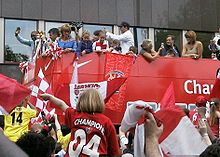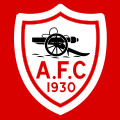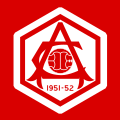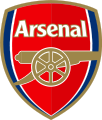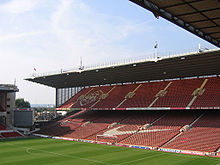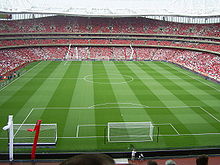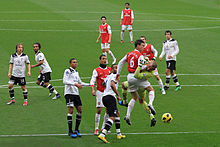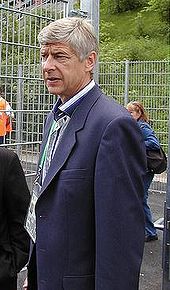- Arsenal F.C.
-
Arsenal 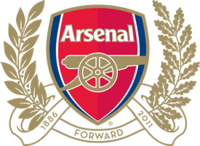
Full name Arsenal Football Club Nickname(s) The Gunners Founded 1886 as Dial Square Ground Emirates Stadium
(Capacity: 60,355[1])Owner Arsenal Holdings plc Chairman Peter Hill-Wood Manager Arsène Wenger League Premier League 2010–11 Premier League, 4th Website Club home page Home coloursAway coloursThird colours Current season
Current seasonArsenal Football Club is a professional English Premier League football club based in North London. One of the most successful clubs in English football, it has won 13 First Division and Premier League titles and 10 FA Cups. Arsenal holds the record for the longest uninterrupted period in the English top flight and is the only side to have completed a Premier League season unbeaten.
Arsenal was founded in 1886 in Woolwich and in 1893 became the first club from the south of England to join the Football League. In 1913, it moved north across the city to Arsenal Stadium in Highbury. In the 1930s the club won five League Championship titles and two FA Cups. After a lean period in the post-war years it won the League and FA Cup Double, in the 1970–71 season, and in the 1990s and first decade of the 21st century won two more Doubles and reached the 2006 UEFA Champions League Final.
Arsenal has a long-standing rivalry with neighbours Tottenham Hotspur, with whom it regularly contests the North London derby. Arsenal is also the third most valuable Association football club in the world as of 2010, valued at $1.2 billion.[2]
History
For more details on this topic, see History of Arsenal F.C. (1886–1966) and History of Arsenal F.C. (1966–present).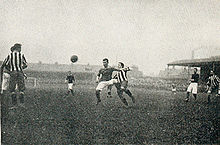 Woolwich Arsenal (in dark shirts) playing Newcastle United (in striped shirts) in an FA Cup semi-final — the club's first ever – at the Victoria Ground, Stoke.
Woolwich Arsenal (in dark shirts) playing Newcastle United (in striped shirts) in an FA Cup semi-final — the club's first ever – at the Victoria Ground, Stoke.
Arsenal Football Club started out as Dial Square in 1886 by workers at the Royal Arsenal in Woolwich, south-east London, and was renamed Royal Arsenal shortly afterwards.[3] The club was renamed again to Woolwich Arsenal after becoming a limited company in 1893.[4] The club became the first southern member of the Football League in 1893, starting out in the Second Division, and won promotion to the First Division in 1904. The club's relative geographic isolation resulted in lower attendances than those of other clubs, which led to the club becoming mired in financial problems and effectively bankrupt by 1910, when they were taken over by businessmen Henry Norris and William Hall.[5] Norris sought to move the club elsewhere, and in 1913, soon after relegation back to the Second Division, Arsenal moved to the new Arsenal Stadium in Highbury, North London; they dropped "Woolwich" from their name the following year.[6] Arsenal only finished in fifth place in 1919, but were nevertheless elected to rejoin the First Division at the expense of local rivals Tottenham Hotspur, by reportedly dubious means.[7]
Arsenal appointed Herbert Chapman as manager in 1925. Having already won the league twice with Huddersfield Town in 1923–24 and 1924–25 (see Seasons in English football), Chapman brought Arsenal their first period of major success. His revolutionary tactics and training, along with the signings of star players such as Alex James and Cliff Bastin, laid the foundations of the club's domination of English football in the 1930s.[8] Under his guidance Arsenal won their first major trophies – victory in the 1930 FA Cup Final preceded two League Championships, in 1930–31 and 1932–33. In addition, Chapman was behind the 1932 renaming of the local London Underground station from "Gillespie Road" to "Arsenal", making it the only Tube station to be named specifically after a football club.[9]
Chapman died suddenly of pneumonia in early 1934, leaving Joe Shaw and George Allison to carry on his successful work. Under their guidance, Arsenal won three more titles, in 1933–34, 1934–35 and 1937–38, and the 1936 FA Cup. As key players retired, Arsenal had started to fade by the decade's end, and then the intervention of the Second World War meant competitive professional football in England was suspended.[10][11][12]
After the war, Arsenal enjoyed a second period of success under Allison's successor Tom Whittaker, winning the league in 1947–48 and 1952–53, and the FA Cup in 1950. Their fortunes waned thereafter; unable to attract players of the same calibre as they had in the 1930s, the club spent most of the 1950s and 1960s in trophyless mediocrity. Even former England captain Billy Wright could not bring the club any success as manager, in a stint between 1962 and 1966.[12][13][14]
Arsenal began winning silverware again with the surprise appointment of club physiotherapist Bertie Mee as manager in 1966. After losing two League Cup finals, they won their first European trophy, the 1969–70 Inter-Cities Fairs Cup. This was followed by an even greater triumph: their first League and FA Cup double in 1970–71.[15] This marked a premature high point of the decade; the Double-winning side was soon broken up and the following decade was characterised by a series of near misses. Arsenal finished as First Division runners-up in 1972–73, lost three FA Cup finals, in 1972, 1978 and 1980, and lost the 1980 Cup Winners' Cup final on penalties. The club's only success during this time was a last-minute 3–2 victory over Manchester United in the 1979 FA Cup Final, widely regarded as a classic.[12][16]
The return of former player George Graham as manager in 1986 brought a third period of glory. Arsenal won the League Cup in 1986–87, Graham's first season in charge. This was followed by a League title win in 1988–89, won with a last-minute goal in the final game of the season against fellow title challengers Liverpool. Graham's Arsenal won another title in 1990–91, losing only one match, won the FA Cup and League Cup double in 1993, and a second European trophy, the Cup Winners' Cup, in 1994.[12][17] Graham's reputation was tarnished when he was found to have taken kickbacks from agent Rune Hauge for signing certain players,[18] and he was dismissed in 1995. His replacement, Bruce Rioch, lasted for only one season, leaving the club after a dispute with the board of directors.[19]
The club's success in the late 1990s and first decade of the 21st century owed a great deal to the 1996 appointment of Arsène Wenger as manager. Wenger brought new tactics, a new training regime and several foreign players who complemented the existing English talent. Arsenal won a second League and Cup double in 1997–98 and a third in 2001–02. In addition, the club reached the final of the 1999–2000 UEFA Cup (losing on penalties to Galatasaray), were victorious in the 2003 and 2005 FA Cups, and won the Premier League in 2003–04 without losing a single match, an achievement which earned the side the nickname "The Invincibles".[20] The club went 49 league matches unbeaten in that season, a national record.[21]
Arsenal finished in either first or second place in the league in eight of Wenger's first eleven seasons at the club, although on no occasion were they able to retain the title.[12] As of March 2011, they were one of only four teams, the others being Manchester United, Blackburn Rovers and Chelsea, to have won the Premier League since its formation in 1992.[22] Arsenal had never progressed beyond the quarter-finals of the Champions League until 2005–06; in that season they became the first club from London in the competition's fifty-year history to reach the final, in which they were beaten 2–1 by Barcelona.[23] In July 2006, they moved into the Emirates Stadium, after 93 years at Highbury.[24]
Arsenal reached the final of the 2010-11 Carling Cup, losing 2-1 to Birmingham City. The club has not gained a major trophy since the 2005 FA Cup.[25]
Crest
Main article: Arsenal F.C. strip#Shirt badgeUnveiled in 1888, Royal Arsenal's first crest featured three cannons viewed from above, pointing northwards, similar to the coat of arms of the Metropolitan Borough of Woolwich. These can sometimes be mistaken for chimneys, but the presence of a carved lion's head and a cascabel on each are clear indicators that they are cannon.[26] This was dropped after the move to Highbury in 1913, only to be reinstated in 1922, when the club adopted a crest featuring a single cannon, pointing eastwards, with the club's nickname, The Gunners, inscribed alongside it; this crest only lasted until 1925, when the cannon was reversed to point westward and its barrel slimmed down.[26] In 1949, the club unveiled a modernised crest featuring the same style of cannon below the club's name, set in blackletter, and above the coat of arms of the Metropolitan Borough of Islington and a scroll inscribed with the club's newly-adopted Latin motto, Victoria Concordia Crescit "victory comes from harmony", coined by the club's programme editor Harry Homer.[26] For the first time, the crest was rendered in colour, which varied slightly over the crest's lifespan, finally becoming red, gold and green. Because of the numerous revisions of the crest, Arsenal were unable to copyright it. Although the club had managed to register the crest as a trademark, and had fought (and eventually won) a long legal battle with a local street trader who sold "unofficial" Arsenal merchandise,[27] Arsenal eventually sought a more comprehensive legal protection. Therefore, in 2002 they introduced a new crest featuring more modern curved lines and a simplified style, which was copyrightable.[28] The cannon once again faces east and the club's name is written in a sans-serif typeface above the cannon. Green was replaced by dark blue. The new crest was criticised by some supporters; the Arsenal Independent Supporters' Association claimed that the club had ignored much of Arsenal's history and tradition with such a radical modern design, and that fans had not been properly consulted on the issue.[29]
Until the 1960s, a badge was worn on the playing shirt only for high-profile matches such as FA Cup finals, usually in the form of a monogram of the club's initials in red on a white background.[30]
The monogram theme was developed into an Art Deco-style badge on which the letters A and C framed a football rather than the letter F, the whole set within a hexagonal border. This early example of a corporate logo, introduced as part of Herbert Chapman's rebranding of the club in the 1930s, was used not only on Cup Final shirts but as a design feature throughout Highbury Stadium, including above the main entrance and inlaid in the floors.[31] From 1967, a white cannon was regularly worn on the shirts, until replaced by the club crest, sometimes with the addition of the nickname "The Gunners", in the 1990s.[30]
In the 2011–2012 season, Arsenal will celebrate their 125th year anniversary. The celebrations will include a modified version of the current crest worn on their jerseys for the season. The crest is all white, surrounded by 15 oak leaves to the right and 15 laurel leaves to the left. The oak leaves represent the 15 founding members of the club who met at the Royal Oak pub. The 15 laurel leaves represent the design detail on the six pence pieces paid by the founding fathers to establish the club. The laurel leaves also represent strength.To complete the crest, 1886 and 2011 are shown on either sides of the motto "Forward" at the bottom of the crest.[32]
-
The 'monogram' badge as used in the 1930 FA Cup Final
-
The 'Art Deco' badge as used in the 1952 FA Cup Final
Colours
For more details on this topic, see Arsenal F.C. strip.Arsenal's original home colours. The team wore a similar kit (but with redcurrant socks) during the 2005–06 season. For much of Arsenal's history, their home colours have been bright red shirts with white sleeves and white shorts, though this has not always been the case. The choice of red is in recognition of a charitable donation from Nottingham Forest, soon after Arsenal's foundation in 1886. Two of Dial Square's founding members, Fred Beardsley and Morris Bates, were former Forest players who had moved to Woolwich for work. As they put together the first team in the area, no kit could be found, so Beardsley and Bates wrote home for help and received a set of kit and a ball.[3] The shirt was redcurrant, a dark shade of red, and was worn with white shorts and blue socks.[33]
In 1933, Herbert Chapman, wanting his players to be more distinctly dressed, updated the kit, adding white sleeves and changing the shade to a brighter pillar box red. Two possibilities have been suggested for the origin of the white sleeves. One story reports that Chapman noticed a supporter in the stands wearing a red sleeveless sweater over a white shirt; another was that he was inspired by a similar outfit worn by the cartoonist Tom Webster, with whom Chapman played golf.[34] Regardless of which story is true, the red and white shirts have come to define Arsenal and the team have worn the combination ever since, aside from two seasons. The first was 1966–67, when Arsenal wore all-red shirts;[33] this proved unpopular and the white sleeves returned the following season. The second was 2005–06, the last season that Arsenal played at Highbury, when the team wore commemorative redcurrant shirts similar to those worn in 1913, their first season in the stadium; the club reverted to their normal colours at the start of the next season.[34] In the 2008–09 season, Arsenal replaced the traditional all-white sleeves with red sleeves with a broad white stripe.[33]
Arsenal's home colours have been the inspiration for at least three other clubs. In 1909, Sparta Prague adopted a dark red kit like the one Arsenal wore at the time;[34] in 1938, Hibernian adopted the design of the Arsenal shirt sleeves in their own green and white strip.[35] In 1920, Sporting Clube de Braga's manager returned from a game at Highbury and changed his team's green kit to a duplicate of Arsenal's red with white sleeves and shorts, giving rise to the team's nickname of Os Arsenalistas.[36] These teams still wear these designs to this day.
For many years Arsenal's away colours were white shirts and either black or white shorts. Since the 1969–70 season, they have worn yellow and blue, but there have been exceptions. They wore a green and navy away kit in 1982–83, and since the early 1990s and the advent of the lucrative replica kit market, the away colours have been changed regularly. During this period the designs have been either two-tone blue designs, or variations on the traditional yellow and blue, such as the metallic gold and navy strip used in the 2001–02 season, and the yellow and dark grey used from 2005 to 2007.[37] As of 2009, the away kit is changed every season, and the outgoing away kit becomes the third-choice kit if a new home kit is being introduced in the same year.[38]
Arsenal's shirts have been made by manufacturers including Bukta (from the 1930s until the early 1970s), Umbro (from the 1970s until 1986), Adidas (1986–1994), and Nike (since 1994). Like those of most other major football clubs, Arsenal's shirts have featured sponsors' logos since the 1980s; sponsors include JVC (1982–1999), Sega (1999–2002), O2 (2002–2006), and Emirates (from 2006).[33][34]
Stadiums
For most of their time in south-east London, Arsenal played at the Manor Ground in Plumstead, apart from a three-year period at the nearby Invicta Ground between 1890 and 1893. The Manor Ground was initially just a field, until the club installed stands and terracing for their first Football League match in September 1893. They played their home games there for the next twenty years (with two exceptions in the 1894–95 season), until the move to north London in 1913.[39][40]
Widely referred to as Highbury, Arsenal Stadium was the club's home from September 1913 until May 2006. The original stadium was designed by the renowned football architect Archibald Leitch, and had a design common to many football grounds in the UK at the time, with a single covered stand and three open-air banks of terracing.[41] The entire stadium was given a massive overhaul in the 1930s: new Art Deco West and East stands were constructed, opening in 1932 and 1936 respectively, and a roof was added to the North Bank terrace, which was bombed during the Second World War and not restored until 1954.[41]
Highbury could hold over 60,000 spectators at its peak, and had a capacity of 57,000 until the early 1990s. The Taylor Report and Premier League regulations obliged Arsenal to convert Highbury to an all-seater stadium in time for the 1993–94 season, thus reducing the capacity to 38,419 seated spectators.[42] This capacity had to be reduced further during Champions League matches to accommodate additional advertising boards, so much so that for two seasons, from 1998 to 2000, Arsenal played Champions League home matches at Wembley, which could house more than 70,000 spectators.[43]
Expansion of Highbury was restricted because the East Stand had been designated as a Grade II listed building and the other three stands were close to residential properties.[41] These limitations prevented the club from maximising matchday revenue during the 1990s and first decade of the 21st century, putting them in danger of being left behind in the football boom of that time.[44] After considering various options, in 2000 Arsenal proposed building a new 60,355-capacity stadium at Ashburton Grove, since renamed the Emirates Stadium, about 500 metres south-west of Highbury.[45] The project was initially delayed by red tape and rising costs,[46] and construction was completed in July 2006, in time for the start of the 2006–07 season.[47] The stadium was named after its sponsors, the airline company Emirates, with whom the club signed the largest sponsorship deal in English football history, worth around £100 million;[48] some fans referred to the ground as Ashburton Grove, or the Grove, as they did not agree with corporate sponsorship of stadium names.[49] The stadium will be officially known as Emirates Stadium until at least 2012, and the airline will be the club's shirt sponsor until the end of the 2013–14 season.[48] From the start of the 2010–11 season on, the stands of the stadium have been officially known as North Bank, East Stand, West Stand and Clock end.[50]
Arsenal's players train at the Shenley Training Centre in Hertfordshire, a purpose-built facility which opened in 1999.[51] Before that the club used facilities on a nearby site owned by the University College of London Students' Union. Until 1961 they had trained at Highbury.[52] Arsenal's Academy under-18 teams play their home matches at Shenley, while the reserves play their games at Underhill, home of Barnet FC.[53]
Supporters
Arsenal fans often refer to themselves as "Gooners", the name derived from the team's nickname, "The Gunners". The fanbase is large and generally loyal, and virtually all home matches sell out; in 2007–08 Arsenal had the second-highest average League attendance for an English club (60,070, which was 99.5% of available capacity),[54] and as of 2006, the fourth-highest all-time average attendance.[55] The club's location, adjoining wealthy areas such as Canonbury and Barnsbury, mixed areas such as Islington, Holloway, Highbury, and the adjacent London Borough of Camden, and largely working-class areas such as Finsbury Park and Stoke Newington, has meant that Arsenal's supporters have come from across the usual class divides.
Like all major English football clubs, Arsenal have a number of domestic supporters' clubs, including the Arsenal Football Supporters Club, which works closely with the club, and the Arsenal Independent Supporters' Association, which maintains a more independent line. The Arsenal Supporters' Trust promotes greater participation in ownership of the club by fans. The club's supporters also publish fanzines such as The Gooner, Highbury High, Gunflash and the less cerebral Up The Arse!. In addition to the usual English football chants, supporters sing "One-Nil to the Arsenal" (to the tune of "Go West") and "Boring, Boring Arsenal", which used to be a common taunt from opposition fans but is now sung ironically by Arsenal supporters when the team is playing well.[56]
There have always been Arsenal supporters outside of London, and since the advent of satellite television, a supporter's attachment to a football club has become less dependent on geography. Consequently, Arsenal have a significant number of fans from beyond London and all over the world; in 2007, 24 UK, 37 Irish and 49 other overseas supporters clubs were affiliated with the club.[57] A 2005 report by Granada Ventures, which at the time owned a 9.9% stake in the club, estimated Arsenal's global fanbase at 27 million.[58]
Arsenal's longest-running and deepest rivalry is with their nearest major neighbours, Tottenham Hotspur; matches between the two are referred to as North London derbies.[59] Other rivalries within London include those with Chelsea, Fulham and West Ham United. In addition, Arsenal and Manchester United developed a strong on-pitch rivalry in the late 1980s, which intensified in recent years when both clubs were competing for the Premier League title[60] – so much so that a 2003 online poll by the Football Fans Census listed Manchester United as Arsenal's biggest rivals, followed by Tottenham and Chelsea.[61] A 2008 poll listed the Tottenham rivalry as more important.[62]
Ownership and finances
Arsenal's parent company, Arsenal Holdings plc, operates as a non-quoted public limited company, whose ownership is considerably different from that of other football clubs. Only 62,217 shares in Arsenal have been issued,[1][63] and they are not traded on a public exchange such as the FTSE or AIM; instead, they are traded relatively infrequently on PLUS (AFC), a specialist market. At 31 August 2010, a single share in Arsenal had a mid price of £10,250, which set the club's market capitalisation value at approximately £637.74m.[64] The club made a pre-tax operating profit (excluding player transfers) of £62.7m in the year ending 31 May 2009, from a turnover of £313.3m.[65]
In April 2010, business magazine Forbes ranked Arsenal as the third most valuable football team in the world, after Manchester United and Real Madrid, valuing the club at $1.181bn (£768m), excluding debt.[2]
The largest shareholder on the Arsenal board is American sports tycoon Stan Kroenke, who launched a bid for the club in 2007,[66] and in November 2009 increased his holding to 18,594 shares (29.9%).[67]
A rival bid to Kroenke's came from Red & White Securities, which is co-owned by Russian billionaire Alisher Usmanov and London-based financier Farhad Moshiri.[68] Red & White launched its bid in August 2007, buying the stake held by former Arsenal vice-chairman David Dein, and as at February 2009 owned 15,555 shares (25.0%) in the club.[69] This led to press speculation of a bidding war between Kroenke and Usmanov.[68] However, Kroenke agreed not to purchase more than 29.9% of the club until at least September 2009,[70] while the rest of the board have first option on each others' shares until October 2012.[71]
In April 2011, Stan Kroenke was rumoured to be in "advanced talks" with Arsenal over a possible takeover.[72]
As of October 2011, Kroenke owns 41,574 shares (66.82%) and Red & White Securities own 18,261 shares (29.35%).[73] Under company law Kroenke, as majority shareholder, is obliged to make an offer for the remaining shares in the club.
Kit manufacturers and shirt sponsors
Kit manufacturers
Shirt sponsors
- 1981–1999: JVC
- 1999–2002: Dreamcast (1st and 3rd shirts) & Sega (2nd shirt)
- 2002–2006: O2
- 2006 – present: Fly Emirates
In popular culture
Arsenal have appeared in a number of media "firsts". On 22 January 1927, their match at Highbury against Sheffield United was the first English League match to be broadcast live on radio.[74];[75] A decade later, on 16 September 1937, an exhibition match between Arsenal's first team and the reserves was the first football match in the world to be televised live.[76][77]Arsenal also featured in the first edition of the BBC's Match of the Day, which screened highlights of their match against Liverpool at Anfield on 22 August 1964.[78][79] BSkyB's coverage of Arsenal's January 2010 match against Manchester United was the first live public broadcast of a sports event on 3D television.[80][81]
As one of the most successful teams in the country, Arsenal have often featured when football is depicted in the arts in Britain. They formed the backdrop to one of the earliest football-related films, The Arsenal Stadium Mystery (1939).[82] The film centres on a friendly match between Arsenal and an amateur side, one of whose players is poisoned while playing. Many Arsenal players appeared as themselves and manager George Allison was given a speaking part.[83] More recently, the book Fever Pitch by Nick Hornby was an autobiographical account of Hornby's life and relationship with football and Arsenal in particular. Published in 1992, it formed part of the revival and rehabilitation of football in British society during the 1990s.[84] The book was twice adapted for the cinema – the 1997 British film focuses on Arsenal's 1988–89 title win,[85] and a 2005 American version features a fan of baseball's Boston Red Sox.[86]
Arsenal have often been stereotyped as a defensive and "boring" side, especially during the 1970s and 1980s;[56][87] many comedians, such as Eric Morecambe, made jokes about this at the team's expense. The theme was repeated in the 1997 film The Full Monty, in a scene where the lead actors move in a line and raise their hands, deliberately mimicking the Arsenal defence's offside trap, in an attempt to co-ordinate their striptease routine.[83] Another film reference to the club's defence comes in the film Plunkett & Macleane, in which two characters are named Dixon and Winterburn after Arsenal's long-serving full backs – the right-sided Lee Dixon and the left-sided Nigel Winterburn.[83]
The 1991 television comedy sketch show Harry Enfield & Chums featured a sketch from the characters Mr Cholmondly-Warner and Grayson where the Arsenal team of 1933, featuring exaggerated parodies of fictitious amateur players take on the Liverpool team of 1991.[88]
Arsenal Ladies
Arsenal Ladies is the women's football club affiliated to Arsenal. Founded in 1987, they turned semi-professional in 2002 and are managed by Laura Harvey.[89] Arsenal Ladies are the most successful team in English women's football. In the 2008–09 season, they won all three major English trophies – the FA Women's Premier League, FA Women's Cup and FA Women's Premier League Cup,[90] and, as of 2009, were the only English side to have won the UEFA Women's Cup, having done so in the 2006–07 season as part of a unique quadruple.[91] The men's and women's clubs are formally separate entities but have quite close ties; Arsenal Ladies are entitled to play once a season at the Emirates Stadium, though they usually play their home matches at Boreham Wood.[92]
In the community
In 1985, Arsenal founded a community scheme, "Arsenal in the Community", which offered sporting, social inclusion, educational and charitable projects. The club support a number of charitable causes directly and in 1992 established The Arsenal Charitable Trust, which by 2006 had raised more than £2 million for local causes.[93] An ex-professional and celebrity football team associated with the club also raised money by playing charity matches.[94]
In the 2009/10 season Arsenal announced that they had raised a record breaking £818,897 for the Great Ormond Street Hospital Children's Charity. The original target was £500,000 but thanks to the overwhelming support from fans, players, directors and staff. They were able to smash the target.[95]
On September 2011, Arsenal won their case against Alicia Simon, a Seville resident who has now been forced by the Spanish Patent and Trademark Office to change the name of her shop "Arsenale". Ms Simon registered the name of her shop before she even opened it in 2007 and has faced litigation from the North London club ever since.[96]
Statistics and records
For more details on this topic, see List of Arsenal F.C. records and statistics.David O'Leary holds the record for Arsenal appearances, having played 722 first-team matches between 1975 and 1993. Fellow centre half and former captain Tony Adams comes second, having played 669 times. The record for a goalkeeper is held by David Seaman, with 564 appearances.[97]
Thierry Henry is the club's top goalscorer with 226 goals in all competitions between 1999 and 2007,[98] having surpassed Ian Wright's total of 185 in October 2005.[99] Wright's record had stood since September 1997, when he overtook the longstanding total of 178 goals set by winger Cliff Bastin in 1939.[100] Henry also holds the club record for goals scored in the League, with 174,[98] a record that had been held by Bastin until February 2006.[101]
Arsenal's record home attendance is 73,707, for a UEFA Champions League match against RC Lens on 25 November 1998 at Wembley Stadium, where the club formerly played home European matches because of the limits on Highbury's capacity. The record attendance for an Arsenal match at Highbury is 73,295, for a 0–0 draw against Sunderland on 9 March 1935,[97] while that at Emirates Stadium is 60,161, for a 2–2 draw with Manchester United on 3 November 2007.[102]
Arsenal have also set records in English football, including the most consecutive seasons spent in the top flight (84 as of 2010–11) and the longest run of unbeaten League matches (49 between May 2003 and October 2004).[21] This included all 38 matches of their title-winning 2003–04 season, when Arsenal became only the second club to finish a top-flight campaign unbeaten, after Preston North End (who played only 22 matches) in 1888–89.[20]
Arsenal also set a Champions League record during the 2005–06 season by going ten matches without conceding a goal, beating the previous best of seven set by A.C. Milan. They went a record total stretch of 995 minutes without letting an opponent score; the streak ended in the final, when Samuel Eto'o scored a 76th-minute equaliser for Barcelona.[23]
Players
First-team squad
- As of 31 August 2011.[103]
Note: Flags indicate national team as has been defined under FIFA eligibility rules. Players may hold more than one non-FIFA nationality.
No. Position Player 1 
GK Manuel Almunia 2 
MF Abou Diaby 3 
DF Bacary Sagna 4 
DF Per Mertesacker 5 
DF Thomas Vermaelen (vice-captain) 6 
DF Laurent Koscielny 7 
MF Tomáš Rosický 8 
MF Mikel Arteta 9 
FW Park Chu-Young 10 
FW Robin van Persie (captain) 11 
DF André Santos 13 
GK Wojciech Szczęsny 14 
FW Theo Walcott 15 
FW Alex Oxlade-Chamberlain 16 
MF Aaron Ramsey No. Position Player 17 
MF Alex Song 18 
DF Sébastien Squillaci 19 
MF Jack Wilshere 20 
DF Johan Djourou 21 
GK Łukasz Fabiański 23 
MF Andrei Arshavin 24 
GK Vito Mannone 25 
DF Carl Jenkinson 26 
MF Emmanuel Frimpong 27 
FW Gervinho 28 
DF Kieran Gibbs 29 
FW Marouane Chamakh 30 
MF Yossi Benayoun (on loan from Chelsea) 31 
FW Ryo Miyaichi For recent transfers, see 2011–12 Arsenal F.C. season.
Reserve squad
Note: Flags indicate national team as has been defined under FIFA eligibility rules. Players may hold more than one non-FIFA nationality.
No. Position Player 33 
FW Benik Afobe 34 
MF Chuks Aneke 37 
DF Daniel Boateng 38 
DF George Brislen-Hall 39 
MF Francis Coquelin 40 
MF Craig Eastmond 43 
DF Sead Hajrović 44 
MF Conor Henderson 45 
DF Gavin Hoyte No. Position Player 47 
GK Sean McDermott 48 
MF Jernade Meade 49 
DF Ignasi Miquel 50 
FW Rhys Murphy 53 
MF Oğuzhan Özyakup 55 
MF Sanchez Watt 56 
DF Nico Yennaris 59 
GK Damian Martinez Out on loan
Note: Flags indicate national team as has been defined under FIFA eligibility rules. Players may hold more than one non-FIFA nationality.
No. Position Player 11 
FW Carlos Vela (at Real Sociedad until the end of the 2011–12 season)[106] 41 
FW Luke Freeman (at Stevenage until 8 January 2012)[107] 46 
MF Henri Lansbury (at West Ham until the end of the 2011–12 season)[108] No. Position Player 52 
FW Nicklas Bendtner (at Sunderland until the end of the 2011–12 season)[109] — 
FW Joel Campbell (at Lorient until the end of the 2011–12 season)[110] — 
MF Denílson (at São Paulo until the end of the 2011–12 season)[111] Notable players
Current technical staff
Position Name Manager Arsène Wenger Assistant manager Pat Rice First team coach Boro Primorac Reserve team coach Neil Banfield Youth team coach Steve Bould Goalkeeping coach Gerry Peyton Fitness coach Tony Colbert Physiotherapist Colin Lewin Club doctor Gary O'Driscoll Kit manager Vic Akers Chief scout Steve Rowley Head of youth development Liam Brady Managers
There have been eighteen permanent and five caretaker managers of Arsenal since the appointment of the club's first professional manager, Thomas Mitchell in 1897.[115] The club's longest-serving manager as of 2009, in terms of both length of tenure and number of games overseen, is Arsène Wenger, who was appointed in 1996.[116][117] Wenger is also Arsenal's only manager from outside the United Kingdom.[117] Two Arsenal managers have died in the job – Herbert Chapman and Tom Whittaker.[118]
Honours
Domestic
- First Division (until 1992) and Premier League[12][119]
- Winners (13): 1930–31, 1932–33, 1933–34, 1934–35, 1937–38, 1947–48, 1952–53, 1970–71, 1988–89, 1990–91, 1997–98, 2001–02, 2003–04
- Runners-up (8): 1925–26, 1931–32, 1972–73, 1998–99, 1999–2000, 2000–01, 2002–03, 2004–05
- Runners-up (1): 1903–04
- Winners (10): 1930, 1936, 1950, 1971, 1979, 1993, 1998, 2002, 2003, 2005
- Runners-up (7): 1927, 1932, 1952, 1972, 1978, 1980, 2001
- FA Community Shield (FA Charity Shield before 2002)[120]
- Winners (12): 1930, 1931, 1933, 1934, 1938, 1948, 1953, 1991 (shared), 1998, 1999, 2002, 2004
- Runners-up (7): 1935, 1936, 1979, 1989, 1993, 2003, 2005
European
- Runners-up (1): 2005–06
- European Cup Winners' Cup[12]
- UEFA Cup[12]
- Runners-up (1): 1999-00
- Runners-up (1): 1994
- Winners (1): 1969–70
Arsenal's tally of thirteen League Championships is the third highest in English football, after Liverpool and Manchester United,[121] while the total of ten FA Cups is the second highest, after Manchester United.[122] Arsenal have achieved three League and FA Cup "Doubles" (in 1971, 1998 and 2002), a record shared with Manchester United,[12][123] and in 1993 were the first side in English football to complete the FA Cup and League Cup double.[124] They were also the first London club to reach the final of the UEFA Champions League, in 2006.[125]
Arsenal have one of the best top-flight records in history, having finished below fourteenth only seven times. Arsenal also have the highest average league finishing position for the period 1900–1999, with an average league placing of 8.5.[126] In addition, they are one of only six clubs to have won the FA Cup twice in succession, in 2002 and 2003.[127] Arsenal also hold the record for the longest unbeaten run in English football at 49 games,[citation needed] and also are the only team to have gone an entire Premier League season unbeaten in 2003–04.[citation needed]
As of 2011 they have also consistently qualified for the Champions League having managed to enter the group stages 14 years running.[citation needed]
Footnotes
- ^ a b "Statement of Accounts and Annual Report 2006/2007 (p43)" (PDF). Arsenal Holdings plc. May 2007. http://www.arsenal.com/assets/_files/documents/jul_08/gun__1215525940_Arsenal_Annual_Report_May_2007.pdf. Retrieved 11 August 2008.
- ^ a b "Arsenal". Forbes. 21 April 2010. http://www.forbes.com/lists/2010/34/soccer-10_Arsenal_340006.html. Retrieved 25 April 2010.
- ^ a b Soar, Phil & Tyler, Martin (2005). The Official Illustrated History of Arsenal. Hamlyn. p. 23. ISBN 978-0-600-61344-2.
- ^ "Royal Arsenal becomes Woolwich Arsenal". Andy Kelly's Arsenal Resource Website. http://homepage.ntlworld.com/andy.kelly/arsenal/record/namechange.htm. Retrieved 13 October 2010.
- ^ Soar & Tyler (2005). The Official Illustrated History of Arsenal. pp. 32–33.
- ^ Soar & Tyler (2005). The Official Illustrated History of Arsenal. p. 40.
- ^ It has been alleged that Arsenal's promotion, on historical grounds rather than merit, was thanks to underhand actions by Norris, who was chairman of the club at the time; see History of Arsenal F.C. (1886–1966) for more details. These allegations range from political machinations to outright bribery; no firm proof of any wrongdoing has ever been found. A brief account is given in Soar & Tyler (2005). The Official Illustrated History of Arsenal. p. 40. A more detailed account can be found in Spurling, Jon (2004). Rebels for the Cause: The Alternative History of Arsenal Football Club. Mainstream. pp. 38–41. ISBN 978-1-84018-900-1.
- ^ Soar & Tyler (2005). The Official Illustrated History of Arsenal. p. 18.
- ^ "London Underground and Arsenal present The Final Salute to Highbury". Transport for London. 12 January 2006. http://www.tfl.gov.uk/static/corporate/media/newscentre/archive/3709.html. Retrieved 12 August 2011.
- ^ "Arsenal clinch a hat-trick of titles". Arsenal F.C. http://www.arsenal.com/history/herbert-chapman/arsenal-clinch-a-hat-trick-of-titles. Retrieved 27 November 2009.
- ^ Brown, Tony (2007). Champions all!. Nottingham: SoccerData. pp. 6–7. ISBN 1-905891-02-4. http://www.soccer.mistral.co.uk/books/ch6-10.pdf.
- ^ a b c d e f g h i j k l m n o "Arsenal". Football Club History Database. Richard Rundle. http://www.fchd.info/ARSENAL.HTM. Retrieved 23 October 2009.
- ^ "Post-War Arsenal – Overview". Arsenal F.C. http://www.arsenal.com/history/post-war-arsenal/post-war-arsenal-overview. Retrieved 27 November 2009.
- ^ Brown (2007). Champions all!. p. 7.
- ^ Galvin, Robert. "Bertie Mee". Football Hall of Fame. National Football Museum. http://www.nationalfootballmuseum.com/pages/fame/Inductees/bertiemee.htm. Retrieved 23 October 2009.
- ^ A 2005 poll of English football fans rated the 1979 FA Cup Final the 15th greatest game of all time. Reference: Winter, Henry (19 April 2005). "Classic final? More like a classic five minutes". Daily Telegraph. http://www.telegraph.co.uk/sport/main.jhtml?xml=/sport/2005/04/19/sfnwin19.xml. Retrieved 11 August 2008.
- ^ Clarke, Andy (26 March 2009). "Top Ten: Title Run-ins". Sky Sports. http://www.skysports.com/story/0,19528,11670_3335042,00.html. Retrieved 7 December 2009.
- ^ Graham was banned for a year by the Football Association for his involvement in the scandal after he admitted he had received an "unsolicited gift" from Hauge. Reference: Collins, Roy (18 March 2000). "Rune Hauge, international man of mystery". The Guardian. http://football.guardian.co.uk/News_Story/0,,148114,00.html. Retrieved 11 August 2008. The case is given a detailed treatment in Bower, Tom (2003). Broken Dreams. Simon & Schuster. ISBN 978-0-7434-4033-2.
- ^ Moore, Glenn (13 August 1996). "Rioch at odds with the system". The Independent. http://www.independent.co.uk/sport/rioch-at-odds-with-the-system-1309564.html. Retrieved 23 October 2009.
- ^ a b Hughes, Ian (15 May 2004). "Arsenal the Invincibles". BBC Sport. http://news.bbc.co.uk/sport1/hi/football/teams/a/arsenal/3713537.stm. Retrieved 11 August 2008.
- ^ a b Fraser, Andrew (25 October 2004). "Arsenal run ends at 49". BBC Sport. http://news.bbc.co.uk/sport1/hi/football/teams/a/arsenal/3950453.stm. Retrieved 27 August 2008.
- ^ Ross, James M. "FA Premier League Champions 1993–2007". Rec.Sport.Soccer Statistics Foundation. http://www.rsssf.com/tablese/engchamp.html#c1993. Retrieved 11 August 2008.
- ^ a b "2005/06: Ronaldinho delivers for Barça". UEFA. 17 May 2007. http://www.uefa.com/competitions/ucl/history/season=2005/intro.html. Retrieved 11 August 2008.
- ^ Aizlewood, John (23 July 2006). "Farewell Bergkamp, hello future". The Times (UK). http://www.timesonline.co.uk/tol/sport/football/article691484.ece. Retrieved 23 October 2009.
- ^ http://www.thesun.co.uk/sol/homepage/sport/football/3816819/Cesc-Fabregas-Arsenal-trophy-drought-is-far-from-over.html%7C url=http://www.timesonline.co.uk/tol/sport/football/article691484.ece | title=Cesc Fabregas: Arsenal Title Drought is Far From Over |work=The Sun |location=UK | last=Gilbert |first=Mark | date=15 September 2011 | accessdate=15 September 2011}}
- ^ a b c "The Crest". Arsenal F.C. http://www.arsenal.com/history/the-crest. Retrieved 11 August 2008.
- ^ Free, Dominic (4 June 2003). "Arsenal v. Reed in the Court of Appeal". Michael Simkins LLP. http://www.simkins.co.uk/ebulletins/DAFArsenalReed.aspx. Retrieved 11 August 2008.
- ^ "Arsenal go for a makeover". BBC Sport. 1 February 2004. http://news.bbc.co.uk/sport1/hi/football/teams/a/arsenal/1795444.stm. Retrieved 11 August 2008.
- ^ "Crestfallen" (PDF). Arsenal Independent Supporters' Association. Archived from the original on 8 November 2006. http://web.archive.org/web/20061108191039/http://www.aisa.org/pdfs/crest_leaflet.pdf. Retrieved 11 August 2008.
- ^ a b "The Arsenal shirt badge". Arsenal F.C. http://www.arsenal.com/news/news-archive/the-arsenal-shirt-badge. Retrieved 24 January 2010.
- ^ "The Art Deco crest". Arsenal F.C. http://www.arsenal.com/news/news-archive/the-art-deco-crest. Retrieved 24 January 2010.
- ^ "125th anniversary crest". Arsenal F.C. http://www.arsenal.com/news/news-archive/125-years-in-the-making-anniversary-crest. Retrieved 1 May 2011.
- ^ a b c d "Arsenal". Historical Football Kits. D & M Moor. http://www.historicalkits.co.uk/Arsenal/Arsenal.htm. Retrieved 8 December 2006.
- ^ a b c d "Arsenal Kit Design". Arsenal F.C. http://www.arsenal.com/history/kit-design. Retrieved 8 November 2008.
- ^ "Hibernian". Historical Football Kits. D & M Moor. http://www.historicalkits.co.uk/Scottish_Football_League/Hibernian/hibernian.htm. Retrieved 11 August 2008.
- ^ Rui Matos Pereira (21 October 2005). "Secret of Braga's success". UEFA. https://video.uefa.com/news/newsid=356684.html. Retrieved 23 January 2011.
- ^ "Arsenal Change Kits". Historical Football Kits. D & M Moor. http://www.historicalkits.co.uk/Arsenal/Arsenal-change-kits.html. Retrieved 27 November 2009.
- ^ "Club Charter". Arsenal F.C. http://www.arsenal.com/the-club/corporate-info/the-club-charter. Retrieved 23 October 2009.
- ^ Inglis, Simon (1996) [1985]. Football Grounds of Britain (3rd ed.). London: CollinsWillow. pp. 16–17. ISBN 0-00-218426-5.
- ^ "Suspension of the Plumstead Ground". The Times: p. 6. 7 February 1895.
- ^ a b c "A Conservation Plan for Highbury Stadium, London" (PDF). Islington Council. February 2005. http://www.islington.gov.uk/DownloadableDocuments/Environment/Pdf/highburyconservationplan_2005.pdf. Retrieved 11 August 2008.
- ^ "Highbury". Arsenal F.C. Archived from the original on 11 January 2008. http://web.archive.org/web/20080111223345/http://www.arsenal.com/article.asp?thisNav=The+Club&article=344883&Title=Highbury.
- ^ "Arsenal get Wembley go-ahead". BBC Sport. 24 July 1998. http://news.bbc.co.uk/1/hi/sport/football/138932.stm. Retrieved 11 August 2008.
- ^ Garner, Clare (18 August 1997). "Arsenal consider leaving hallowed marble halls". The Independent. http://www.independent.co.uk/sport/arsenal-consider-leaving-hallowed-marble-halls-1246012.html. Retrieved 23 October 2009.
- ^ "Arsenal unveil new stadium plans". BBC Sport. 7 November 2000. http://news.bbc.co.uk/sport1/hi/football/teams/a/arsenal/1011234.stm. Retrieved 11 August 2008.
- ^ "Arsenal stadium delay". BBC Sport. 16 April 2003. http://news.bbc.co.uk/sport1/hi/football/teams/a/arsenal/2953273.stm. Retrieved 11 August 2008.
- ^ "Bergkamp given rousing farewell". BBC Sport. 22 July 2006. http://news.bbc.co.uk/sport2/hi/football/teams/a/arsenal/5203954.stm. Retrieved 23 August 2007.
- ^ a b "Arsenal name new ground". BBC Sport. 5 October 2004. http://news.bbc.co.uk/sport1/hi/football/teams/a/arsenal/3715678.stm. Retrieved 11 August 2008.
- ^ Dawes, Brian (2006). "The 'E' Word". Arsenal World. Footymad. http://www.arsenal-world.co.uk/news/loadnews.asp?cid=TMNW&id=283908. Retrieved 11 August 2008.
- ^ Emirates Stadium stands to be re-named Arsenal FC, 19 July 2010
- ^ Taylor, David (21 October 1999). "Arsenal gets a complex". The Architects' Journal. http://www.architectsjournal.co.uk/arsenal-gets-a-complex/774448.article. Retrieved 20 January 2010.
- ^ "The Training Centre". Arsenal F.C. http://www.arsenal.com/the-club/training-centre. Retrieved 11 August 2008.
- ^ "Get to Underhill Stadium". Arsenal F.C. http://www.arsenal.com/news/news-archive/how-to-get-to...-underhill-stadium. Retrieved 7 September 2008.
- ^ Kempster, Tony. "Attendances 2007/08". http://www.tonykempster.co.uk/prematt.htm?comp=1. Retrieved 11 August 2008.
- ^ "All Time League Attendance Records". NUFC.com. Archived from the original on 29 October 2007. http://web.archive.org/web/20071029153705/http://www.nufc.com/html/attendance-all-time.html. Retrieved 11 August 2008. Please note that some pre-war attendance figures used by this source were estimates and may not be entirely accurate.
- ^ a b Noble, Kate (22 September 2002). "Boring, Boring Arsenal". Time. http://www.time.com/time/magazine/article/0,9171,353528,00.html. Retrieved 11 August 2008.
- ^ "Fans Report 2006/2007" (Word document). Arsenal F.C. http://www.arsenal.com/assets/_files/documents/jul_08/gun__1215526755_charter_report_20062007.doc. Retrieved 7 September 2008.
- ^ "Arsenal FC – the Premiership's fastest growing football brand" (Word document). Granada Ventures. 5 August 2005. Archived from the original on 4 June 2007. http://web.archive.org/web/20070604205337/http://www.granadaventures.co.uk/newsdocs/doc28.doc.
- ^ Coggin, Stewart. "The North London derby". Premier League. http://www.premierleague.com/page/Magazinedettail/0,,12306~1195275,00.html. Retrieved 7 September 2008.
- ^ "The Classic: Arsenal-Manchester Utd". FIFA. 17 January 2007. http://www.fifa.com/worldfootball/clubfootball/news/newsid=109924.html. Retrieved 23 October 2009.
- ^ "Club Rivalries Uncovered" (PDF). Football Fans Census. http://www.footballfanscensus.com/issueresults/Club_Rivalries_Uncovered_Results.pdf. Retrieved 7 September 2008.
- ^ "Football Rivalries Report 2008". The New Football Pools. http://www.footballpools.com/football-fever/rivalries-league.html. Retrieved 7 September 2008.
- ^ "Statement of Accounts and Annual Report 2009/2010 (p41)" (PDF). Arsenal Holdings plc. Sep 2010. http://www.arsenal.com/assets/_files/documents/sep_10/gun__1285660177_Arsenal_Holdings_plc_Annual_Re.pdf. Retrieved 12 January 2011.
- ^ "Arsenal Holdings plc". PLUS Markets Group. http://www.plusmarketsgroup.com/details.shtml?ISIN=GB0030895238/GBP/PLUS-exn. Retrieved 5 November 2009.
- ^ "Arsenal Holdings plc: 2009 Financial results". Arsenal Holdings plc. 28 September 2009. http://www.arsenal.com/news/news-archive/arsenal-holdings-plc-results-for-year-end-ma. Retrieved 5 November 2009.
- ^ Scott, Matt and Allen, Katie (6 April 2007). "Takeover gains pace at Arsenal with 9.9% sale". The Guardian. http://football.guardian.co.uk/News_Story/0,,2051488,00.html. Retrieved 11 August 2008.
- ^ "Kroenke increases stake in Arsenal Holdings". Arsenal F.C. 5 November 2009. http://www.arsenal.com/news/news-archive/kroenke-increases-stake-in-arsenal-holdings. Retrieved 6 December 2009.
- ^ a b "Russian buys Dein's Arsenal stake". BBC News. 30 August 2007. http://news.bbc.co.uk/1/hi/business/6971124.stm. Retrieved 11 August 2008.
- ^ "TR-1: Notifications of Major Interests in Shares". PLUS Markets. 16 February 2009. http://www.plusmarketsgroup.com/story.shtml?ISIN=GB0030895238/GBX/PLUS-exn&NewsID=1234794458000759. Retrieved 17 February 2009.
- ^ "Kroenke joins Arsenal's Board of Directors". Arsenal F.C. 19 September 2008. http://www.arsenal.com/news/news-archive/other. Retrieved 19 September 2008.
- ^ "Arsenal board announce revised 'lock-down' agreement". Arsenal F.C. 18 October 2007. http://www.arsenal.com/news/news-archive/board-announce-revised-lock-down-agreement. Retrieved 11 August 2008.
- ^ http://sportshaze.com/england/english-premier-league/american-tycoon-in-advanced-talks-with-gunners-2826
- ^ http://www.arsenal.com/the-club/corporate-info/the-arsenal-board
- ^ Firsts, Lasts & Onlys: Football – Paul Donnelley (Hamlyn, 2010)
- ^ "It Happened at Highbury: First live radio broadcast". Arsenal F.C. http://www.arsenal.com/news/news-archive/programme-it-happened-at-highbury. Retrieved 11 August 2008.
- ^ Firsts, Lasts & Onlys: Football – Paul Donnelley (Hamlyn, 2010)
- ^ "Happened on this day – 16 September". BBC Sport. 16 September 2002. http://news.bbc.co.uk/sport1/hi/funny_old_game/2260280.stm. Retrieved 11 August 2008.
- ^ Firsts, Lasts & Onlys: Football – Paul Donnelley (Hamlyn, 2010)
- ^ "History of Match of the Day". BBC Sport. 14 February 2003. http://news.bbc.co.uk/sport1/hi/tv_and_radio/match_of_the_day/879960.stm. Retrieved 11 August 2008.
- ^ Firsts, Lasts & Onlys: Football – Paul Donnelley (Hamlyn, 2010)
- ^ "Fans trial first live 3D sports event". Sydney Morning Herald. Associated Press. 1 February 2010. http://news.smh.com.au/breaking-news-sport/fans-trial-first-live-3d-sports-event-20100201-n7bo.html. Retrieved 16 March 2010.
- ^ "The Arsenal Stadium Mystery". IMDb. http://www.imdb.com/title/tt0031055/. Retrieved 11 August 2008.
- ^ a b c "Arsenal at the movies". Arseweb. http://www.arseweb.com/other/movies.html. Retrieved 11 August 2008.
- ^ "Nick Hornby". The Guardian. 22 July 2008. http://www.guardian.co.uk/books/2008/jun/13/nick.hornby. Retrieved 7 September 2008. "Critically acclaimed and commercial dynamite, Fever Pitch helped to make football trendy and explain its appeal to the soccerless"
- ^ "Fever Pitch (1997)". IMDb. http://www.imdb.com/title/tt0119114/. Retrieved 7 September 2008.
- ^ "Fever Pitch (2005)". IMDb. http://www.imdb.com/title/tt0332047/. Retrieved 7 September 2008.
- ^ May, John (19 May 2003). "No more boring, boring Arsenal". BBC Sport. http://news.bbc.co.uk/sport1/hi/football/fa_cup/3037789.stm. Retrieved 7 September 2008.
- ^ Association Football – Harry Enfield – Mr Cholmondley-Warner YouTube
- ^ "Laura Harvey". Arsenal FC. http://www.arsenal.com/ladies/coaching-staff/laura-harvey. Retrieved 7 July 2010.
- ^ "Arsenal Ladies Honours". Arsenal F.C. http://www.arsenal.com/ladies/ladies-honours. Retrieved 21 May 2007.
- ^ Mawhinney, Stuart (7 May 2007). "Arsenal clinch quadruple". The Football Association. http://www.thefa.com/TheFACup/FACompetitions/TheFAWomensCup/NewsandFeatures/2009/FAWCMatchReport.aspx. Retrieved 23 October 2009.
- ^ "Get to Boreham Wood". Arsenal F.C. http://www.arsenal.com/ladies/boreham-wood-directions. Retrieved 7 September 2008.
- ^ "Arsenal Charity Ball raises over £60,000". Arsenal F.C. 11 May 2006. http://www.arsenal.com/news/news-archive/arsenal-charity-ball-raises-over-pound-60-000. Retrieved 11 August 2008.
- ^ "Ex-Pro and Celebrity XI". Arsenal F.C. Archived from the original on 22 August 2008. http://web.archive.org/web/20080822031124/http://www.arsenal.com/the-club/community/ex-pro-and-celebrity-xi. Retrieved 11 August 2008.
- ^ Arsenal smash fundraising target for GOSH Arsenal FC, 2 August 2010
- ^ "Arsenal force Spanish hat shop to change name". inside World Soccer. 9 September 2011. http://www.insideworldsoccer.com/2011/09/arsenal-force-spanish-hat-shop-to.html.
- ^ a b "Club Records". Arsenal F.C. http://www.arsenal.com/history/club-records. Retrieved 23 October 2009.
- ^ a b "Squad profiles: Thierry Henry". BBC Sport. http://news.bbc.co.uk/sport1/shared/bsp/hi/football/statistics/players/h/henry_22698.stm. Retrieved 11 August 2008.
- ^ "Wright salutes Henry's goal feat". BBC Sport. 19 October 2005. http://news.bbc.co.uk/sport1/hi/football/teams/a/arsenal/4356664.stm. Retrieved 11 August 2008.
- ^ Ward, Rupert. "Arsenal vs Bolton. 13/09/97". Arseweb. http://www.arseweb.com/97-98/reports/130997.html. Retrieved 11 August 2008.
- ^ "Arsenal 2–3 West Ham". BBC Sport. 1 February 2006. http://news.bbc.co.uk/sport1/hi/football/eng_prem/4657206.stm. Retrieved 23 October 2009.
- ^ "Man Utd game attracts record attendance". Arsenal F.C. 5 November 2007. http://www.arsenal.com/news/news-archive/man-utd-game-attracts-record-attendance. Retrieved 11 August 2008.
- ^ "First Team Players". Arsenal F.C.. http://www.arsenal.com/first-team/players. Retrieved 30 August 2011.
- ^ "Reserve Players". Arsenal F.C.. http://www.arsenal.com/reserves-youth/players. Retrieved 13 August 2009.
- ^ "Arsenal FC". UEFA. http://www.uefa.com/uefachampionsleague/season=2012/clubs/club=52280/index.html. Retrieved 9 August 2011.
- ^ "Vela and Botelho go on loan to spain". 16 August 2011. http://www.arsenal.com/news/news-archive/vela-and-botelho-go-on-loan-to-spain. Retrieved 16 August 2011.
- ^ "Stevenage land Arsenal striker Luke Freeman". BBC Sport. 17 November 2011. http://news.bbc.co.uk/sport1/hi/football/15779584.stm. Retrieved 17 November 2011.
- ^ "Lansbury moves on loan to West Ham United". http://www.arsenal.com/news/news-archive/lansbury-moves-on-loan-to-west-ham-united 31 August 2011.
- ^ "Nicklas Bendtner loaned to Sunderland". 31 August 2011. http://www.arsenal.com/news/news-archive/nicklas-bendtner-loaned-to-sunderland. Retrieved 31 August 2011.
- ^ "Campbell and Sunu heading for Lorient". 31 August 2011. http://www.arsenal.com/news/news-archive/campbell-and-sunu-heading-for-lorient.
- ^ "Denilson returns to Brazil for Sao Paulo loan". Arsenal.com. 20 July 2011. http://www.arsenal.com/news/news-archive/denilson-returns-to-brazil-for-sao-paulo-loan. Retrieved 20 July 2011.
- ^ "First Team Coaching Staff". Arsenal F.C. http://www.arsenal.com/first-team/coaching-staff#Coaching%20Staff. Retrieved 23 October 2009.
- ^ "Reserves & Youth Coaching Staff". Arsenal F.C. http://www.arsenal.com/reserves-youth/coaching-staff#Coaching%20Staff. Retrieved 23 October 2009.
- ^ Ducker, James (5 September 2009). "Scouting networks extend search for talent all over the world". The Times (UK). http://www.timesonline.co.uk/tol/sport/football/article6822692.ece. Retrieved 23 October 2009.
- ^ Soar & Tyler (2005). The Official Illustrated History of Arsenal. p. 30.
- ^ "Wenger hungry for further success". BBC Sport. 2 October 2009. http://news.bbc.co.uk/sport1/hi/football/eng_prem/8286929.stm. Retrieved 6 December 2009.
- ^ a b Davies, Christopher (8 December 2008). "700 and not out: Arsenal boss Wenger looking to celebrate memorable day at Porto". Daily Mail (UK). http://www.dailymail.co.uk/sport/football/article-1092959/700-Arsenal-boss-Wenger-looking-celebrate-memorable-day-Porto.html. Retrieved 6 December 2009.
- ^ "The Managers". Arsenal F.C. http://www.arsenal.com/history/the-managers. Retrieved 7 September 2008.
- ^ a b Up until 1992, the top division of English football was the Football League First Division; since then, it has been the Premier League. Similarly until 1992, the Second Division was the second tier of league football, which since the 2004–05 season has been known as The Championship.
- ^ The trophy was known as the Charity Shield until 2001, and as the Community Shield since then. Reference: Ross, James (28 August 2009). "England – List of FA Charity/Community Shield Matches". RSSSF. http://www.rsssf.com/tablese/engsupcuphist.html. Retrieved 12 January 2010.
- ^ Ross, James M (28 August 2009). "England – List of Champions". RSSSF. http://www.rsssf.com/tablese/engchamp.html#sall. Retrieved 23 October 2009.
- ^ Ross, James M (12 June 2009). "England FA Challenge Cup Finals". RSSSF. http://www.rsssf.com/tablese/engcuphist.html#sall. Retrieved 23 October 2009.
- ^ Stokkermans, Karel (24 September 2009). "Doing the Double: Countrywise Records". RSSSF. http://www.rsssf.com/miscellaneous/doublerec.html#coun. Retrieved 23 October 2009.
- ^ Collins, Roy (20 May 2007). "Mourinho collects his consolation prize". The Daily Telegraph. http://www.telegraph.co.uk/sport/football/2313666/Mourinho-collects-his-consolation-prize.html. Retrieved 6 December 2009. "Chelsea's Cup came wrapped in an extra ribbon, only the second team after Arsenal in 1993 to win both domestic cups."
- ^ "Arsenal Football Club". Premier League. http://www.premierleague.com/page/arsenal. Retrieved 11 August 2008.
- ^ Hodgson, Guy (17 December 1999). "How consistency and caution made Arsenal England's greatest team of the 20th century". The Independent. http://www.independent.co.uk/sport/football-how-consistency-and-caution-made-arsenal-englands-greatest-team-of-the-20th-century-1133020.html. Retrieved 23 October 2009.
- ^ Ross, James M (12 June 2009). "England FA Challenge Cup Finals". RSSSF. http://www.rsssf.com/tablese/engcuphist.html. Retrieved 23 October 2009.
Further reading
- Hayes, Dean (2007). Arsenal: The Football Facts. John Blake. ISBN 978-1-84454-433-2.
- Hornby, Nick (1992). Fever Pitch. Indigo. ISBN 978-0-575-40015-3.
- Maidment, Jem (2006). The Official Arsenal Encyclopedia. Hamlyn. ISBN 978-0-600-61549-1.
- Soar, Phil & Tyler, Martin (2000). The Official Illustrated History of Arsenal. Hamlyn. ISBN 978-0-600-60175-3.
- Spurling, Jon (2004). Rebels for the Cause: The Alternative History of Arsenal Football Club. Mainstream. ISBN 978-1-84018-900-1.
- Stammers, Steve (2008). Arsenal: The Official Biography – The Compelling Story of an Amazing Club. Hamlyn. ISBN 978-0-60061-892-8.
External links
Listen to this article (info/dl)
This audio file was created from a revision of Arsenal F.C. dated 2007-04-15, and does not reflect subsequent edits to the article. (Audio help)More spoken articlesOfficial websites
- Official website (Chinese) (English) (Japanese) (Korean)
- Arsenal at the Premier League official website
- Arsenal at the UEFA official website
News sites
- Arsenal on BBC Sport: Club News – Recent results – Upcoming fixtures – Club stats
- Arsenal news from Sky Sports
- Arsenal News
Other
- Arsenal F.C. companies grouped at OpenCorporates
Arsenal Football Club Players · Managers · Seasons · Records · Supporters · Ownership History Home stadium Training ground Other teams Media Rivalries Related articles Affiliated Academies  Category:Arsenal F.C. ·
Category:Arsenal F.C. ·  Portal:Association football ·
Portal:Association football ·  Arsenal task force ·
Arsenal task force ·  Commons:Arsenal F.C.
Commons:Arsenal F.C.Original Premier League clubs, 1992–93 Arsenal · Aston Villa · Blackburn Rovers · Chelsea · Coventry City · Crystal Palace · Everton · Ipswich Town · Leeds United · Liverpool · Manchester City · Manchester United · Middlesbrough · Norwich City · Nottingham Forest · Oldham Athletic · Queens Park Rangers · Sheffield United · Sheffield Wednesday · Southampton · Tottenham Hotspur · Wimbledon2011–12 UEFA Champions League Currently playing in the
group stageGroup A: Bayern Munich · Manchester City · Napoli · Villarreal
Group B: CSKA Moscow · Internazionale · Lille · Trabzonspor
Group C: Basel · Benfica · Manchester United · Oțelul Galați
Group D: Ajax · Dinamo Zagreb · Lyon · Real Madrid
Group E: Bayer Leverkusen · Chelsea · Genk · Valencia
Group F: Arsenal · Borussia Dortmund · Marseille · Olympiacos
Group G: APOEL · Porto · Shakhtar Donetsk · Zenit St. Petersburg
Group H: BATE Borisov · Barcelona · Milan · Viktoria PlzeňEliminated in the
play-off roundChampions: Copenhagen · Maccabi Haifa · Malmö FF · Sturm Graz · Wisła Kraków
Non-champions: Odense · Rubin Kazan · Twente · Udinese · ZürichEliminated in the
third qualifying roundChampions: Ekranas · HJK Helsinki · Litex Lovech · Maribor · Partizan · Rangers · Rosenborg · Shamrock Rovers · Slovan Bratislava · Zestafoni
Non-champions: Dynamo Kyiv · Panathinaikos · Standard Liège · VasluiEliminated in the
second qualifying roundBangor City · Breiðablik · Borac Banja Luka · Dacia Chişinău · F91 Dudelange · HB Tórshavn · Linfield · Mogren · Neftchi Baku · Pyunik · Skënderbeu Korçë · Škendija · Skonto · Tobol Kostanay · Valletta · VideotonEliminated in the
first qualifying roundRound and draw dates · Qualifying phase and play-off round · Group stage · Knockout phase · Final Football in London League teams
(tiers 1-4)AFC Wimbledon • Arsenal • Barnet • Brentford • Charlton Athletic • Chelsea • Crystal Palace • Dagenham & Redbridge • Fulham • Leyton Orient • Millwall • Queens Park Rangers • Tottenham Hotspur • West Ham UnitedNon-League teams
(tiers 5-8)Bedfont Town • Bromley • Carshalton Athletic • Corinthian-Casuals • Cray Wanderers • Croydon Athletic • Dulwich Hamlet • Enfield Town • Hampton & Richmond Borough • Harrow Borough • A.F.C. Hayes • Hayes & Yeading United • Hendon • A.F.C. Hornchurch • Ilford • Kingstonian • Metropolitan Police • North Greenford United • Northwood • Redbridge • Sutton United • Thamesmead Town • Tooting & Mitcham United • Uxbridge • Waltham Forest • Wealdstone • Welling United • Wingate & FinchleyRivalries Cup competitions London Senior Cup • London Intermediate Cup • London Junior Cup • London Charity Cup (defunct) • London Challenge Cup (defunct)See also Categories:- Arsenal F.C.
- English football clubs
- Association football clubs established in 1886
- Premier League clubs
- Former Football League clubs
- FA Cup winners
- Football League Cup winners
- G-14 clubs
- Football clubs in London
- Companies formerly listed on the Alternative Investment Market
- 1886 establishments in England
Wikimedia Foundation. 2010.

